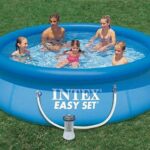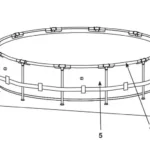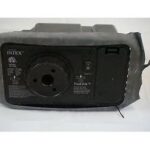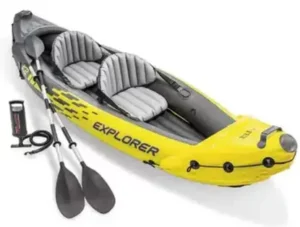

INTEX Explorer K2 Inflatable Kayak
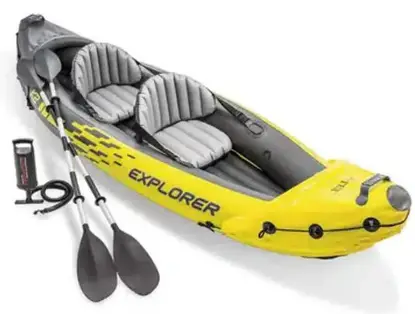
Introduction
It contains details of the craft, the equipment supplied or fitted, its systems, and information on its operation and maintenance. Please read it carefully, and familiarize yourself with the craft before using it. If this is your first craft, or you are changing to a type of craft you are not familiar with, for your own comfort and safety, please ensure that you obtain handling and operating experience before assuming command of the craft. Your dealer or national sailing federation or yacht club will be pleased to advise you of local sea school, or competent instructors. HULL IDENTIFICATION NUMBER (HIN) WHICH IS PRINTED ON THE KAYAK’S HULL IN THE FOLLOWING BOX
 Manufacture’s Certification
Manufacture’s Certification
Our kayaks comply with ISO 6185 standard established by the International Organization for Standardization. NMMA (FOR USA ONLY) certification means that the kayak, sold in the United States, has been judged by the National Marine Manufacture’s Association to be in compliance with the U.S. Coast Guard Regulations and American Boat and Yacht Council (ABYC) standards and recommended practices.
Safety
Craft designed for voyages on sheltered coastal waters, small bays, small lakes, rivers and canals when conditions up to, and including, wind force 4 and significant wave heights up to, and including, 0.3 m may be experienced with occasional waves of 0.5 m maximum height, for example from passing vessels.
WARNING
- This is not a life saving device. Use only under competent supervision. Never allow diving into this product. Never leave in or near the water when not in use. Never tow from any vehicle.
- TYPE IIIB, inflatable kayaks intended for beach use, short-time and short-distance cruising.
- Beware of offshore winds and currents.
- Never navigate alone.
- Do not exceed the maximum recommended capacities.
- Overloading violates regulations.
- Everyone on board must wear a Personal Floatation Device PFD.
- Use caution when stepping or climbing aboard the kayak. Step into the center of the kayak for maximum stability.
- Distribute the weight of passengers, gear, tackle box, and accessories so that the kayak sits level fore front to aft back and side to side.
- Do not use your kayak if you suspect a puncture or leak.
- Adults should inflate the chambers in numbered sequence.
- Not for white water rafting or any other extreme sports activities.
- Not for commercial or rental use.
- Follow these rules to avoid drowning, paralysis or other serious injuries.
Manufacturer’s Recommendation
The total number of persons and total weight shall not exceed the limits printed on the kayak. Please refer to the boat’s hull label for the actual values of your boat.
| TABLE A | ||||||
| MODEL | Lh | Wh | + | |||
| m | m | lbs | kg | bar (psi) | ||
| Challenger K1 | 2.74 | 0.76 | 220 | 100 | 1 | 0.069 (1.00) |
| Challenger K2 | 3.51 | 0.76 | 400 | 180 | 2 | 0.069 (1.00) |
| Explorer K2 | 3.12 | 0.91 | 400 | 180 | 2 | 0.069 (1.00) |
CRAFT LABEL FORMAT
| ISO 6185 PART 1 TYPE |
|
| Do not overinflate or use high pressure air compressor to inflate. Adults should inflate the chambers with cold air in numbered sequence.
This boat not rated for propulsion by a motor. Use the enclosed ruler to check while inflating. |
|
| BY INTEX | |
MAXIMUM CAPACITIES |
|

PERSONS OR kg (Lbs) / PERSONNES OU KG POUNDS, PERSONS, GEAR / KG, PERSONNES ET EQUIPEMENT |
|
| DESIGN COMPLIANCE WITH NMM A REQUIREMENTS BELOW IS VERIFIED. MFGR. RESPONSIBLE FOR PRODUCTION CONTROL | |
| LOAD CAPACITY (BASIC FLOTATION)
RECOMMENDED WORKING PRESSURE FOR EACH CHAMBER Certified by the National Marine Manufacturers Association using ABYC standards Certifié par la National Marine Manufacturers Association en utilisant les normes ABYC |
|
- Manufacturer’s recommended maximum load capacity.
- Maximum person’s capacity.
- Manufacturer’s name and country of origin.
- Model name and number.
- Manufacturer’s recommended working pressure.
- NMMA (for USA only) certification means that the kayak, sold in the United States, has been judged by the National Marine Manufacture’s
- Association to be in compliance with the U.S.
- Coast Guard Regulations and American Boat and Yacht Council ABYC standards and recommended practices.
- Hull identification number (HIN).
Description
Challenger Kayak Series
K1

K2
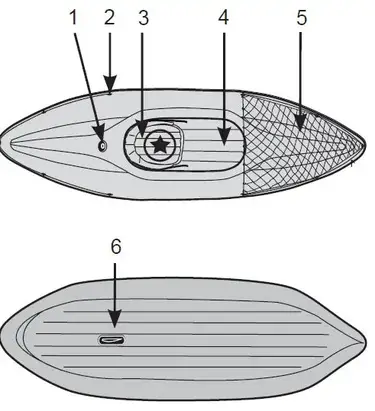
Explorer K2
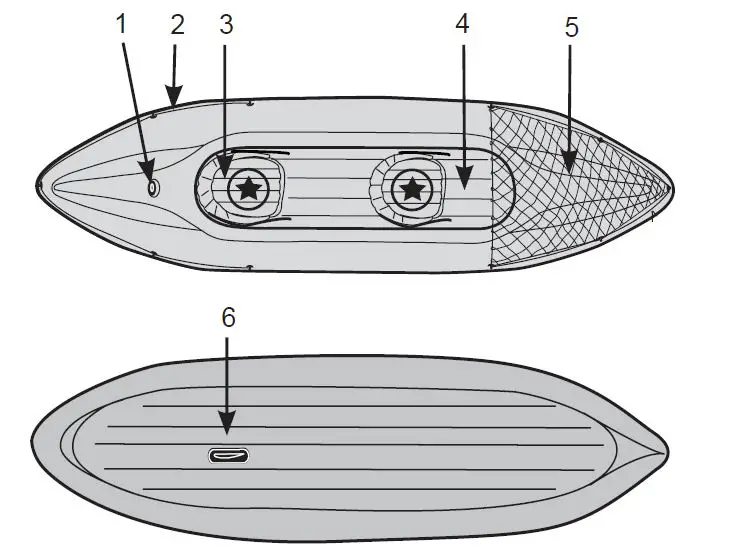
Recommended seating arrangement of the occupants.
| Descriptions | |
| 1 | Boston valve |
| 2 | Grab Line |
| 3 | Seat or seat cushion |
| 4 | Inflatable floor |
| 5 | Cargo net |
| 6 | Skeg |
| 7 | Drain valve |
NOTE
Drawings for illustration purpose only. Actual product may vary. Not to scale.

Inflating Instructions
Before starting, locate a clean area free of stones or other sharp objects. Unroll the kayak so it is laid out flat, and locate your pump. Use a hand or foot operated air pump to inflate the boat. Do not use high-pressure air compressors. Adults should inflate the chambers following the numerical sequence marked on the valves. It is very important to follow the numerical sequence; failure to do so will result in an improperly inflated boat. Fill each chamber until it is stiff to the touch but NOT hard. Use the enclosed ruler to check the main chamber for proper inflation. DO NOT OVER INFLATE. Fill with cold air only.
IMPORTANT
Air temperature and weather condition do affect the internal air pressure of inflatable products. In cold weather the product will lose some pressure due to the fact that the air will contract. If this occurs, you may want to add a little air to the product. However, in
hot weather, the air will expand. You must let some air out to prevent the product from failing due to overpressure.
How to Use Boston Valve
- Double valve cap (valve lets air in, not out).
- Quick deflation cap.
- Unscrew Double valve cap.
- Insert output end of air pump into valve and fill. Do not over inflate or use high pressure compressor.
- To deflate: unscrew quick-deflation cap.
CAUTION
Double valve does not operate when this cap is off. Do not unscrew this cap while boat or inflatable is in water.

Seat Installation Certain Models
- Inflate each seat cushion slowly to about 75% of its capacity.
- Finish inflating the seat cushions slowly until it is firm to the touch but NOT hard. DO NOT OVER INFLATE.
- To disassemble the seats, deflate the seats first and reverse the installation procedures.
- Some seat cushions after inflation are tuck in directly into the fore, mid or aft locations of the kayak cockpit.
Grab Line Installation Certain Models
IMPORTANT
To properly install the inflatable boat’s grab line and/or accessory lines, first inflate the boat. If is necessary, begin the grab line installation at the rear of the boat by threading it through the rope holders completely around the outside of the boat. Tie the two loose ends in a square knot at the rear end of the boat. For Explorer kayak series, make sure the grab line is threaded through the rope holders completely on the outside of the boat, even after the rear or front cover is removed. The grab line shall be attached to the boat at all time.

Paddle Assembly
- Press and align the push-bottom on the short shaft with the paddle blade hole, ensure the push bottom is securely snapped onto the paddle blade hole.
- Join the 3 shafts together with the couplers and securely tighten the coupler covers.
- To disassemble, reverse the assembly steps.
- Note is not necessary to detach the paddle blades from the shafts.


Safety and Operating Instructions
Before Departing from the Shore or Dock.Know all required information and inform your passengers
- Take a boating safety course and get hands-on training from your boat dealer or local boating authorities.
- Know all local regulations and hazards related to water activities and boat operation.
- Check weather forecast, local currents, tides and wind conditions.
- Advise someone on land of the time you plan to be back at your starting point.
- Explain basic boat operation to all passengers.
- Children and non-swimmers need special instructions in the use of life jacket or personal floatation devices (PFD).
- Be sure that one of your passengers can operate the boat in case of emergency.
- Learn how to determine the distance you can cover, and remember that bad weather conditions can alter this.
- Review all safety requirements regularly.
Check the working condition of the boat and equipments
- Check inflation pressure.
- Inspect the valves caps.
- Check the load is evenly distributed, fore front to aft back and side to side.
- Make sure that all required safety equipment is on board (check the laws and regulations of the country or locality in which you are boating to see if additional equipment may be needed.
- One personal flotation device PFD per person.
- Air pump, oars, repair kit and tool kit.
- Any other mandatory equipment.
- The boat papers and your boating license if applicable.
- Lights are required if operating after dark.
Rules to Observe During Navigation
- Be responsible, do not neglect the safety rules, this could jeopardize your life and the lives of others.
- Always keep control of your boat.
- Respect local regulations and practices.
- Near the shore, navigate in the designated boating area.
- Remember that weather conditions can rapidly deteriorate. Always be sure that you can reach a shelter rapidly.
- Everyone on board must always wear a personal flotation device PFD.
- Do not drink alcohol or take drugs before or while operating your boat. Maintain passenger sobriety.
- Do not exceed the authorized number of persons or weight.
- Make sure your passengers remain seated at all times.
- At planning speeds, in rough water or during sharp turns, all passengers should position themselves in seats or on the floor.
- No bow riding. Bow riding is illegal in most areas and is extremely dangerous.
- In case of falling, the man overboard is in the way of the propeller.
- Be especially careful when docking.
- Arms and legs may be injured if they are outside the boat.
- Keep clear of swimmers and divers. Always avoid areas where divers/swimmers are in the water.
- Keep a sharp lookout especially when operating near beaches and launch sites.
- The Alpha flag indicates proximity of divers.
- You MUST maintain a safe distance as required by your local boating laws, which may range from 50 meters 164 feet to 91 meters 300 feet.
- Avoid sharp turns at high speeds.
- You could get ejected from the boat.
- Do not make changes in direction without advising passengers.
- Avoid all contact between the buoyancy tubes and sharp objects or aggressive liquids such as acid.
- Do not smoke on board.
Care and Maintenance
The kayak is made of the highest quality materials and complies with ISO 6185 standards. Altering the construction of the kayak will endanger your own safety, safety of the occupants and void the limited warranty. There is very little that you have to do to keep your kayak in good condition for many years. Do not store your kayak inflated. If you store it in a closet, basement or garage, we suggest you pick a cool, dry place, making sure the kayak is clean and dry before you store it – or mold can accumulate. Use as few cleaning agents as possible, do not discharge waste agents into water, and clean your kayak preferably on land. Clean your kayak after a trip to prevent damage from sand, salt water or sun exposure. Most dirt can be removed with a garden hose, a sponge and mild soap. Make sure the kayak is completely dry before storing. Store the product an accessories in a dry temperature
controlled, between 32 degrees Fahrenheit 0 degrees Celsius and 104 degrees Fahrenheit 40 degrees Celsius storage location.
Disassembly and Storage
First clean your kayak thoroughly following the Care and Maintenance instructions.
- Open all air valves, deflate kayak completely and remove all the accessories from the kayak.
- Flip the kayak over. Fold the left side of the kayak over and then fold the right side over the left.
- Fold the bow end twice to the middle of the kayak tightly while forcing out any remaining air repeat this procedure for the stern.
- Replace all air valves’ caps. With two opposing folded sides, fold one end over the other like closing a book. Your kayak is ready for storage. Fold
the kayak loosely and avoid sharp bends, corners and creases which can damage the kayak.
Troubleshooting
If your kayak appears a bit soft, it might not be because of a leak. If the kayak was inflated late in the day with 32 °C 90 °F air, that air might cool down to 25 °C 77 °F overnight. The cooler air exerts less pressure on the hull, so it could appear soft the next morning. If there has been no temperature variation, you need to start looking for a leak.Take a good look at your kayak from just a few feet away. Flip it over and closely check over the outside. Any large leaks should be clearly visible. If you have an idea where your leak is, use a mix of dishwashing liquid and water in a spray bottle, and spray over the suspicious areas. Any leak will produce bubbles that will pinpoint the location of the leak. Check valves for leak, if necessary, spray soapy water around the valve and the valve base.
Repairs
Through constant use you may occasionally puncture your kayak. Most leaks only take a few minutes to repair. Your kayak comes with a repair patch, and additional repair supplies can be ordered from Intex Consumer Service or from our website. First locate the leak soapy water will bubble out from the source of the leak. Thoroughly clean the area surrounding the leak to remove any dirt or grime. Cut a piece of repair patch large enough to overlap the damaged area by approximately 1.5 cm (1/2). Round off the edges, and place the patch on the damaged area and PRESS DOWN FIRMLY. You may want to use a weight on top to keep it in place. Do not inflate in 30 minutes after patching. If the patch does not hold, you can purchase a PVC or silicon based glue for repairing camping mats, tents or shoes from your local market to patch your boat, please refer to the instruction of the glue for patching.
Limited Warranty Intex Inflatable Kayak
Your Intex Inflatable Kayak has been manufactured using the highest quality materials and workmanship. All Intex Inflatable kayaks have been inspected and found free of defects prior to leaving the factory. This limited warranty applies to the Intex Inflatable Kayak only. This limited warranty is in addition to, and not a substitute for, your legal rights and remedies. To the extent that this warranty is inconsistent with any of your legal rights, they take priority. For example, consumer laws across the European Union provide statutory warranty rights in addition to the coverage you receive from this limited warranty: for information on EU-wide consumer laws, please visit the European Consumer Center website at http://ec.europa.eu/
consumers/ecc/contacten/htm. provisions of this limited warranty apply only to the original purchaser. This Limited Warranty is valid for a period of 90-days from the date of purchase. Keep your purchase information with this document, as proof of purchase will be required and must accompany warranty claims or the limited warranty will be invalid. If you find a manufacturing defect in the Intex Inflatable Kayak during the warranty period,
please contact the appropriate Intex Service Center listed in the separate “Authorized Service Centers sheet. If the item is returned as directed by the Intex Service Center, the Service Center will inspect the item and determine the validity of the claim. If the item is covered by the provisions of the warranty, the item will be repaired or replaced, with the same or comparable item (at Intex’s choice) at no charge to you than this warranty, and other legal rights in your country, no further warranties are implied. To the extent possibly in your country, in no event shallIntex be liable to you or any third party for direct or consequential damages arising out of the use of your Intex Inflatable Kayak, or Intex or its agents and employees actions (including the manufacture of the product. If your country does not allow the exclusion or limitation of incidental or consequential damages, this limitation or exclusion does not apply to you. You should note that this limited warranty does not apply in the following circumstances
- If the Intex Inflatable Kayak is subject to negligence, abnormal use or application, accident, improper operation, trailering or towing, improper maintenance or storage;
- If the Intex Inflatable Kayak is subject to damage by circumstances beyond Intex’s control, including but not limited to, punctures, tears, abrasions, or ordinary wear and tear.
- To parts and components not sold by Intex.
- To unauthorized alterations, repairs or disassembly to the kayak by anyone other than Intex Service Center personnel.

